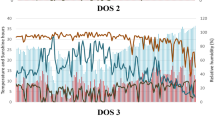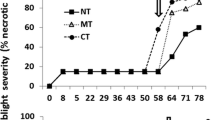Abstract
The effects of inter-row spacing of Leucaena leucocephala in an alley cropping system on the incidence and severity of diseases on intercropped beans (Phaseolus vulgaris L.) and their yield were examined over two years (1993 and 1994) at Chepkoilel Campus in Kenya. Each experiment consisted of three randomized blocks with treatments of three alley widths (2 m,4 m and 8 m) and a treeless control with two intra-row spacings of Leucaena (0.5 m and 1.0 m). Hedgerows were coppiced at 1.0 m height and pruned subsequently at two-to-three months intervals. No fertilizer was applied but Leucaena loppings were incorporated as green leaf manure. Incidence of angular leaf spot (Phaeoisariopsis griseola) and anthracnose (Colletotrichum lindemuthianum) on beans were assessed at three growth stages in each season, using the Centro International de Agricultura Tropical (CIAT) scales. Microclimate was monitored in treatments, in 1994. Angular leaf spot and anthracnose decreased with increasing alley width and were more severe in bean rows adjacent to hedgerows. Light availability and diurnal temperaturereaching the bean canopy increased with alley width but relative humidity and leaf wetness duration decreased. Proximity to hedgerows also had markedly reduced light levels, lower temperatures and higher relative humidity. Higher incidence and severity of angular leaf spot and anthracnose on beans in alleys than on beans in treeless plots were examined in relation to microclimate, inoculum survival and dispersal. The pattern of the diseases was best explained by microclimate changes induced by Leucaena hedgerows, especially effects of humidity.
Access this article
We’re sorry, something doesn't seem to be working properly.
Please try refreshing the page. If that doesn't work, please contact support so we can address the problem.
Similar content being viewed by others
References
Boudreau MA (1993) Effect of inter-cropping beans with maize on the severity of anthracnose of beans in Kenya. Plant Pathology 42: 16–25
Cardona-Alvarez C and Walker JC (1956) Anthracnose of bean. Phytopathology 46: 610–615
CIAT (1987) Standard System for Evaluation of Bean Germplasm. Van Schoonhoven, A. and Pastor-Corrales MA Cali., Columbia
Chambers AY (1969) Relationship of weather conditions to occurrence, severity and control of stem anthracnose of lima beans. Phytopathology (Absract) 59: 1021
FAO-UNESCO (1977) Soil Map of the World. Vol. VI, Africa. UNESCO. Paris
Gathuru EM (1991) Bean anthracnose: Importance of the disease and the genus Colletotrichum. In: CIAT. Proceedings of the first Pan-African Group Meeting on Anthracnose of Beans. Ambo. Ethiopia. pp. 5–11
Kang BT and Wilson GF (1987) The development of alley cropping as a promising agroforestry technology. In: Steppler HA and Nair PKR (eds) Agroforestry a Decade of Development, pp 227–247. ICRAF, Nairobi
Lenne' JM (1991). Diseases of Leucaena species. Tropical pest management 37(3): 281–289
Michieka RW (1981) Weed research in Kenya. A report for the National Council for Science and Technology, Kenya, 6 pp
Mukunya DM and Keya SO (1975). Phaseolus bean production in East Africa. Cyllosted paper, Nairobi University, 71 pp
Singh RP, Ong CK and Saharan N (1989) Above and below ground interactions in alley cropping in semi-arid India. Agroforestry Systems 9: 259–274
Stoetze HAI (1983) Diseases of beans in Kenya. In: Phaseolus Beans Newsletter for Eastern Africa. No. I. September 1983
Sengooba T (1990) Comparison of disease development in beans in purestand and maize intercrop. Annual Report of the Bean Co-operative Improvement 33: 57–58
Tui JC (1981) Anthracnose (Colletotrichum lindemuthianum) on white bean (Phaseolus vulgaris, L.) in southern Ontario: Spread of the disease from an infection focus. Plant Disease Reporter 65: 477–480
Van Rheenen HA, Van Hasselbach OE and Muigai SGS (1981) The effect of growing beans together with maize on the incidence of bean diseases and pests. Netherlands Journal of Plant Pathology 87: 193–199.
Van Schoonoven A and Pastor-Corrales MA (1987) Standard system for evaluation of bean germplasm. Centro International de Agricultura Tropical (CIAT), Publi., Cali., Columbia. p 53
Yamoah CF and Burleigh JR (1990) Alley cropping Sesbania sesban (L) Merill with food crops in the highland region of Rwanda. Agroforestry Systems 10: 169–181
Author information
Authors and Affiliations
Rights and permissions
About this article
Cite this article
Koech, E., Whitbread, R. Disease incidence and severity on beans in alleys between Leucaena hedgerows in Kenya. Agroforestry Systems 49, 85–101 (2000). https://doi.org/10.1023/A:1006311421506
Issue Date:
DOI: https://doi.org/10.1023/A:1006311421506




